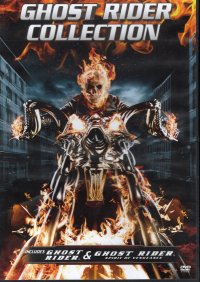 Gentle reader, I will ask you to indulge me here a bit. I saw Ghost Rider recently, but I cannot tell you how recently that would have been since I’ve only been doing movie reports since 2020 here (recently). I mean, I am pretty sure I watched it at Nogglestead, but it could have been on a DVD I rented in my most recent movie store membership days (within the last decade) or on a DVR version I recorded before the last time I cut the cord (also within the last decade, but more last decader than when I had the video store card). Or, gentle reader, it could have been somewhere in the middle where I bought the movie on physical medium, watched it, and put it on the “watched” shelves which are not as deep, extensive, or inscrutible as the Nogglestead bookshelves, but are quite deep never the less.
Gentle reader, I will ask you to indulge me here a bit. I saw Ghost Rider recently, but I cannot tell you how recently that would have been since I’ve only been doing movie reports since 2020 here (recently). I mean, I am pretty sure I watched it at Nogglestead, but it could have been on a DVD I rented in my most recent movie store membership days (within the last decade) or on a DVR version I recorded before the last time I cut the cord (also within the last decade, but more last decader than when I had the video store card). Or, gentle reader, it could have been somewhere in the middle where I bought the movie on physical medium, watched it, and put it on the “watched” shelves which are not as deep, extensive, or inscrutible as the Nogglestead bookshelves, but are quite deep never the less.
At any rate, suffice to say, I have watched Ghost Rider recently. But not in the cinema, so my time between viewings is less than 300.
Most notable about watching the two on successive nights is the great chasm between 2007 and 2012. No, not the political chasm. Not the personal chasm (Old Trees >mother dead > Nogglestead). The whole aesthetic approach to comic movies. Maybe the studios’ understanding, or not, of them.
At any rate, in Ghost Rider, Johnny Blaze works with his father in the circus as a stunt rider. Johnny hopes to leave the circus to be with Roxy, who doesn’t think much of circus folk. When Johnny learns his father is dying of cancer, he signs a deal with the devil to heal his father–and the devil does, but the father dies immediately in a stunt gone bad. Because, you know, the devil. But he says he will call on Johnny when he needs him.
Years later, Johnny is still a stunt rider although a la Evil Knievel, packing stadia with people who want to see his outlandish stunts. Johnny can’t die, so no matter how badly the jumps go, he is all right. But then the devil needs him to help find and prevent another demon loose on the planet from getting his hands on an unfulfilled contract. Sorry for the late notice, but the film starts with Sam Elliot narrating the legend of the Ghost Rider, the devil’s bounty hunter, who was supposed to execute on a contract for 1000 souls but who did not. Blaze gets the powers of the Ghost Rider (on a motorcycle, not a horse).
The film is mostly a series of set pieces where Ghost Rider has to take out the minions of the demon and finally kill the main boss. The subplot revolves around Blaze reuiniting with Roxy–he left her after signing the contract, but she returns as a reporter who scores an interview with him before a big jump.
This film comes from the Before period, before the Marvel Cinematic Universe (as did The Punisher). Mark that.
Ghost Rider: The Spirit of Vengeance (2012) comes five years later and does not extend the story of the first so much as reboots it, albeit with the Nicholas Cage again as the Ghost Rider. The film tells his origin story again, albeit differently, which is much more jarring when you have just seen the original film just the night before. Maybe it worked better after five years, and perhaps people watching this film did not see the first one. At any rate, Idris Elba portrays a holy man of some motorcycle-riding order who comes to an armed monestary of some sort just an armed force attacks it, looking for a boy who is part of some prophecy. The boy’s mother escapes with him, and Idris Elba finds Johnny Blaze hiding out in Europre, trying not to be the Ghost Rider or let the Ghost Rider out. He reluctantly agrees to find the mother and to protect the boy, who is the spawn of the devil and into which the devil eventually wants to put himself in exchange for Elba lifting the curse on Johnny. So that’s what happens with a twist at the climax.
As I mentioned, the two films have a completely different feel to them. The first has a touch of CGI to it–well, okay, a bunch–but it at the core has a certain heart to it that the second does not. The second feels like a series of CGI spectacles stitched together loosely with a plot. Both have Nicholas Cage doing the gonzo Nic Cage thing, but the second is gritter, pared down to the bone and a touch pessimistic or brutal. The second ignores some of the constraints put on the Ghost Rider in the first film–only coming out at night, for example–which might only matter if you watch the two films in close succession, which perhaps only I and Nic Cage do in 2023.
So I liked the first more than the second.
Violante Placido played Nadya, the mother, in the second film.
She was born in Italy to a showbiz family, and most of her work is in her native Italy, although she has appeared in a couple of American movies, including Ghost Rider: Spirit of Vengeance.







She has also released a number of albums under the name “Viola”. Unfortunately, this song is the only one available for online purchase:
A bit more pop than my taste runs.


